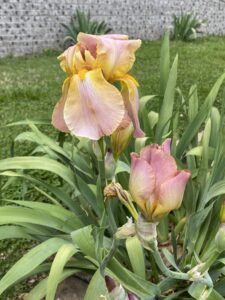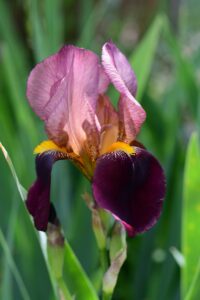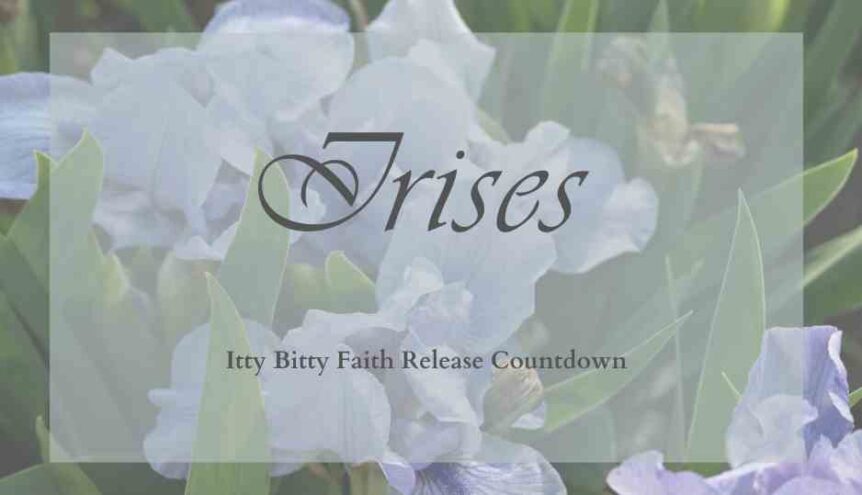 I realize irises are not an uncommon flower, but since it’s the Tennessee state flower, I’d be remiss in not writing a post about this popular perennial. The first time I had irises in my own yard was when I married Chris and moved into his Northern California cabin sitting on twenty acres. There weren’t any irises in the “yard” but there were random plants that seemed to grow wild. I thought it was amazing, because the soil was not conditioned at all, and other than the occasional rainfall, was not watered. In fact, we were in a drought more often than not. But these hardy plants kept blooming. So, if you think you have a black thumb, these beautiful flowers will give you confidence. If you don’t believe me, keep on reading.
I realize irises are not an uncommon flower, but since it’s the Tennessee state flower, I’d be remiss in not writing a post about this popular perennial. The first time I had irises in my own yard was when I married Chris and moved into his Northern California cabin sitting on twenty acres. There weren’t any irises in the “yard” but there were random plants that seemed to grow wild. I thought it was amazing, because the soil was not conditioned at all, and other than the occasional rainfall, was not watered. In fact, we were in a drought more often than not. But these hardy plants kept blooming. So, if you think you have a black thumb, these beautiful flowers will give you confidence. If you don’t believe me, keep on reading.
There was an elderly woman in our church named Lois. She asked us one August if we would divide her irises for her—and we could take however many rhizomes we wanted. It was hot, hard work because of the soil conditions I pointed out above, and, well…it was August! I put the rhizomes in a storage box intending to plant them that fall. Sadly, time got away from me—for two years. When I finally put them in the ground, I was sure they wouldn’t survive. The following spring, up came the green shoots—but no blooms. Knowing nothing about irises, I figured it was because I’d waited so long. The following spring, the green shoots arrived again, looking very healthy, but still no blooms.
The third spring, Lois passed away around the time the green shoots were poking out of the ground. That year, we had dazzling white irises. I like to believe Lois’s sweet spirit had something to do with the timing of those blooms finally coming to fruition. It goes to show that even when the rhizomes sit in a dark box for a couple of years, a little light and a few prayers will bring them back to life.
 There are more than 200 different varieties of irises in every color imaginable. Because of this, the name ‘iris’ comes from the Greek word for ‘rainbow.’ You know how the Greeks loved their gods and goddesses. Well, they had one named Iris who was considered the messenger of the gods—and she was the personification of the rainbow. People believed she was the link between earth and heaven, so they would place purple irises on graves of women who had died to summon this (totally fictional) goddess to help them reach heaven.
There are more than 200 different varieties of irises in every color imaginable. Because of this, the name ‘iris’ comes from the Greek word for ‘rainbow.’ You know how the Greeks loved their gods and goddesses. Well, they had one named Iris who was considered the messenger of the gods—and she was the personification of the rainbow. People believed she was the link between earth and heaven, so they would place purple irises on graves of women who had died to summon this (totally fictional) goddess to help them reach heaven.
The Egyptians also love irises. Many Egyptian buildings have paintings of irises in them. And I specifically remember irises being associated with the French monarchy. Do you remember the Fleur-de-lis? Well, it eventually became the national symbol of France.
These beauties will grow just about anywhere, so whether you’re in the furthest northern regions where the winters are long and cold or in the South, you can have irises in your garden. But before they were ever a landscaper’s dream, the had quite a history. They have been used to create aromatic perfumes and by herbalists as a remedy for coughs and lung conditions.
Not only are irises found in home gardens and bouquets, but they can also be found growing naturally in the wild—which is proof that they are very low maintenance flowers. As an author of inspirational fiction, I love that the irises are also associated with hope, wisdom, and faith. However, depending on the region one lives in, they might have other meanings, as well. In some places, the purple iris is symbolic of royalty and the yellow iris is associated with courage, passion, and admiration.
The iris was designated as the official state flower of Tennessee in 1973 by the 88th General Assembly. Although there was not a specific color chose, by common knowledge, the purple iris is considered the state cultivated flower. No matter the color, they are stunning. I love that I can dig up rhizomes every year and share them with friends and family.
You may not be able to purchase these beauties on Amazon, but be sure to enter here for a chance to win a $25 Gift Card anyway. Maybe you can use them for gardening tools, or seeds, or a book!






